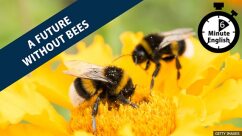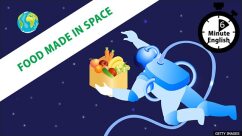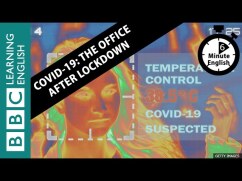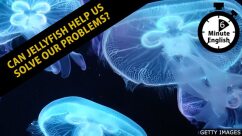robot_artist.pdf
robot_artist.mp3
BBC LEARNING ENGLISH
6 Minute English
Robot artists
Neil
Hello This is 6 Minute English from BBC Learning English I’m Neil
Sam
And I’m Sam
Neil
Do you think robots could ever become intelligent, Sam?
Sam
Well, if you believe Hollywood movies like ‘Robocop’, robots will grow more
powerful than their human creators and take control
Neil
You’ve been watching too many sci-fi movies, Sam! But seriously - do you think
robots will ever be able to think or dream? Could they fall in love or create art?
Sam
It’s hard to say but because of the huge advances in artificial intelligence over
the last ten years, questions like these are being asked more and more
Neil
In this programme we’ll be meeting a very unusual ‘person’ (if that’s the right
word) who could help answer some of these questions She’s called Ai-Da, she’s
an artist who can draw, paint and create sculptures – and she’s a robot
Sam
Yes, the humanoid robot, Ai-Da, uses a robotic arm and a pencil to draw what it
sees with a camera in its eye It’s very life-like and can even talk to the people
whose picture it’s drawing
Neil
We’ll hear more about this extraordinary robot and the team of inventors behind
her soon, but first I have a quiz question The name, Ai-Da, uses the abbreviation
for ‘artificial intelligence’ - AI - to make a woman’s first name, but which famous,
real-life Ada was the robot named after? Was it:
a) Ada Brown?,
b) Ada Lovelace? or,
c) Ada Maris?
Sam
I think it must be, b) Ada Lovelace
Neil
OK, Sam, we’ll find out if that’s right later Of course building a realistic robot
that can see, hold a pencil and draw is not easy
Sam
Behind the creation of Ai-Da was a team led by Cornish robotics company,
Engineered Arts, and supported by engineers in Leeds who built her robotic arms
using AI systems developed at Oxford University
Neil
Here’s chief engineer, Marcus Hold, introducing presenter, Karl Bos, to the still
unfinished Ai -Da for the first time for BBC World Service programme, In The
Studio:
Karl Bos
It’s very strange because on first glance she looks incredibly scary, a bit like
a dystopian robot from the future but when you see her move and express she
becomes incredibly cute
Marcus Hold
People tend to refer to them as ‘he’ or ‘she’, they’re drawn to the robots So
much of our communication is non-verbal – I’m gesturing with my arms, I’m
smiling… and our robots – a big part of their appeal and their human nature is in
the way they behave and move and it’s great that you’re picking up on that from
something that has no skin
Sam
When Karl first meets Ai-Da he sees a wired-up metal skull without skin She
looks like a robot from a dystopia - an imaginary future world where everything
is bad – like the movie ‘Robocop’
Neil
But as Karl spends more time with Ai-Da he begins to see her move and express
herself She smiles, blinks and uses facial expressions and hand gestures known
as non-verbal communication to appear more human
Sam
This human-like behaviour is part of Ai-Da’s appeal - the quality in someone that
makes them attractive and interesting – and soon Karl is calling the robot ‘she’
instead of ‘it’
Neil
Former art gallery owner, Aidan Mellor, manages the Ai-Da project Here he is
speaking to BBC World Service’s, In The Studio, about the complex process
involved in building a working robot:
Aidan Meller
We’ve got the programmers and researchers working at Oxford University and
Goldsmiths and they’re doing their algorithmic programming, programming the
AI that is going to be eventually used for the art pieces that we’re doing… But
we’ve also got a couple of guys who are actually working on her arm – her ability
to draw – and actually getting her to do a compelling drawing of what she sees
There’s some battles still to be won before the show, we will eventually
hopefully iron out all the issues before that time
Sam
One challenge the team faced was building a robotic arm that could allow Ai-Da
to draw pictures that were compelling – exciting, interesting and able to keep
your attention
Neil
In combining an electronic AI brain with mechanical robot eyes and arms there
were many battles to be won – difficulties and technical obstacles to be
overcome
Sam
And at the time of the interview, the team still had some issues to iron out –
removing problems by finding solutions – before Ai-Da’s opening show: an
exhibition of her artwork at The Design Museum in London
Neil
Amazing! It’s nice to think that a robot could be the next Picasso instead of an
out-of-control sci-fi policeman!
Sam
Yes, and the whole project was inspired by a real-life woman – whose name was?
What was the answer to your quiz question, Neil?
Neil
Ah yes, I asked Sam which famous Ada was the real-life inspiration behind the
robot, Ai-Da
Sam
I said, b) Ada Lovelace Was I right?
Neil
You were… right, Sam! Ai-Da is named after Ada Lovelace, the 19th century
English mathematician and first computer programmer in the world
Sam
OK, Neil Let’s recap the vocabulary from this programme, starting
with dystopia - an imaginary future society where everything is bad
Neil
Non-verbal communication is communication using physical gestures and facial
expressions instead of speech
Sam
The appeal of something is a quality it has which people find attractive
Neil
If something is compelling, it holds your attention because you find it so
interesting
Sam
A battle to be won means a problem to be solved or an obstacle to overcome
Neil
And finally, to iron something out means to remove or find solutions to a
problem
Sam
With artificial intelligence improving so fast it may not be too long before we see
robot presenters of Six Minute English!
Neil
But until Sam and I are replaced by AI we hope you’ll join us again next time for
more trending topics and useful vocabulary, here at BBC Learning English Bye
for now!
Sam
Goodbye!
VOCABULARY
dystopia
an imaginary future society where everything is bad
non-verbal communication
communication that does not involve speaking such as using physical gestures
and facial expressions
appeal
the quality in someone that makes them attractive and interesting
compelling
so exciting and interesting that it holds your attention
battles to win
problems to be solved; obstacles to be overcome
iron (something) out
remove or find solutions to a problem









